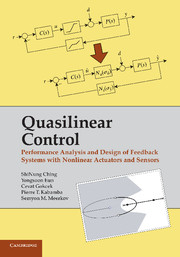 Quasilinear Control
Quasilinear Control Book contents
- Frontmatter
- Contents
- Preface
- 1 Introduction
- 2 Stochastic Linearization of LPNI Systems
- 3 Analysis of Reference Tracking in LPNI Systems
- 4 Analysis of Disturbance Rejection in LPNI Systems
- 5 Design of Reference Tracking Controllers for LPNI Systems
- 6 Design of Disturbance Rejection Controllers for LPNI Systems
- 7 Performance Recovery in LPNI Systems
- 8 Proofs
- Epilogue
- Abbreviations and Notations
- Index
- References
3 - Analysis of Reference Tracking in LPNI Systems
Published online by Cambridge University Press: 01 June 2011
- Frontmatter
- Contents
- Preface
- 1 Introduction
- 2 Stochastic Linearization of LPNI Systems
- 3 Analysis of Reference Tracking in LPNI Systems
- 4 Analysis of Disturbance Rejection in LPNI Systems
- 5 Design of Reference Tracking Controllers for LPNI Systems
- 6 Design of Disturbance Rejection Controllers for LPNI Systems
- 7 Performance Recovery in LPNI Systems
- 8 Proofs
- Epilogue
- Abbreviations and Notations
- Index
- References
Summary
Motivation: This chapter is intended to quantify steady state errors and transient performance of LPNI systems in the problem of tracking reference signals.
For linear systems, the steady state error in tracking deterministic references is characterized by the notion of system type, defined by the poles of the loop gain at the origin. This definition is not applicable to LPNI systems since, if the actuator saturates, controller poles at the origin play a different role than those of the plant and, thus, the loop gain does not define the system type. This motivates the first goal of this chapter, which is to introduce the notion of system type for LPNI systems.
Also in contrast with the linear case, LPNI systems with saturating actuators are not capable of tracking steps with arbitrary amplitudes. This motivates the second goal of this chapter: to introduce and quantify the notion of trackable domains, that is, the sets of step (or ramp, or parabolic) input magnitudes that can, in fact, be tracked by an LPNI system.
As far as the transients are concerned, the usual step tracking measures, such as overshoot, settling time, and so on, are clearly not appropriate for random references. The variance of tracking errors, as it turns out, is not a good measure either, since for the same variance, the nature of tracking errors can be qualitatively different.
Information
- Type
- Chapter
- Information
- Quasilinear ControlPerformance Analysis and Design of Feedback Systems with Nonlinear Sensors and Actuators, pp. 66 - 113Publisher: Cambridge University PressPrint publication year: 2010